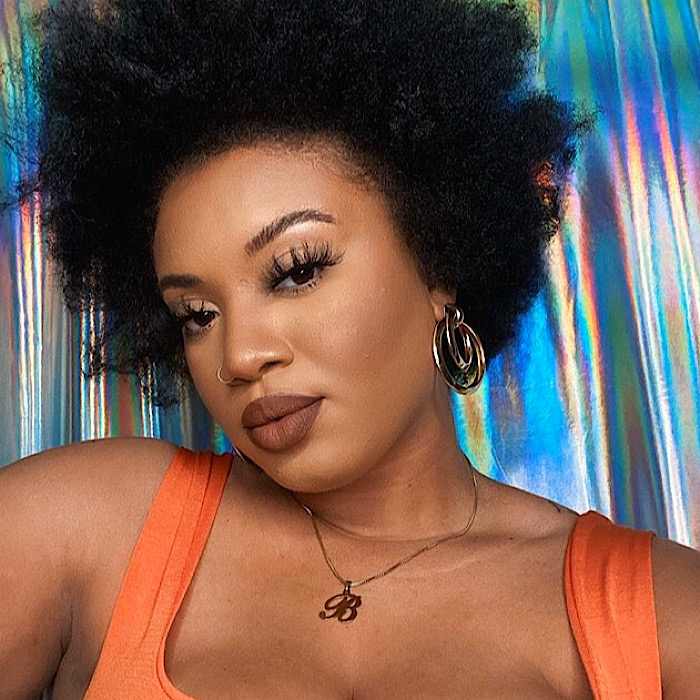
Image Source: @styleme.b
I’ll be the first one to say that, if you want to find a way to make your hair texture a little looser and more manageable, a texturizer is the way to go. But, after years of having one and then transitioning out into my full-on natural hair, I’ll also say that I had no idea how much damage texturizing my hair had done to my scalp (more on that in a sec”> or how long it was going to take to get my “actual hair” into a truly healthy state.
I’ll be honest. A part of this is probably because I texturized too often (like once a month”>. But, I think another part of the issue is that I told myself the lie that a lot of people seem to fall for—that a texturizer is “not really a relaxer”. As you’re about to see in a minute, it most certainly is. That’s why it takes some thoughtful, consistent and patient work to go from wearing a texturized look into being au naturel; especially if you want your natural hair to be as healthy as possible (which I’m sure that you do”>. Here’s why I say that.
1. Your scalp is going to need some serious detoxing.
One of the biggest lies that you can tell yourself is that a texturizer isn’t “really a relaxer”. It is; it’s just that it’s basically the equivalent of a kiddie perm. As someone who used one, off and on, for what seems like forever, I’m here to tell you that once I decided to go completely natural, my scalp went through it. Relaxers contain chemicals that can irritate your scalp, burn your scalp or leave sores, scabs and scars that can damage your hair follicles (more on that in a sec”> and take years to repair. So yes, if you’re thinking about letting your texturizer go, it’s a wise move to devote at least a couple of months to detoxing your scalp so that it can fully heal. If you’d like a few tips on how to do it properly, we’ve got you covered right here.
2. Your hair follicles will probably require pampering.
Although it’s been a few years now since I’ve used a texturizer, there is a spot on the right side of my head, right above my ear, that is just now starting to flourish like the rest of the hair on my head. I know that it’s because I used to let the texturizer sit on my sides so much and for so long that I damaged the hair follicles in that area. As a result, I’ve had to “baby them” just a bit. This included doing things like giving myself scalp massages, applying Jamaican castor oil on my weak(er”> spots, not using as much heat (dryers and even hot showers can wreak havoc on hair follicles over time”>, eating foods that would “feed” my follicles (Eat This Not That has a great article on this topic; you can check it out here“> and taking a multi-vitamin. Again, changes didn’t happen overnight but they did happen. So, please make sure to make this a priority too.
3. Over-the-top deep conditioning will be a must.
When I say that you should go “over-the-top”, all I mean is that, when it comes to deep conditioning your hair during this time, you need to be intentional and consistent. The reason why deep conditioning is so crucial is 1″> the softer your hair is, the more manageable it will be and 2″> the less dry your actual hair is, the less breakage you will experience. If you’re not sure which conditioner to use, we’ve got your back. Check out “6 Deep Conditioners for Transitioning Hair”. Just make sure that you also balance conditioning out with applying protein treatments. Otherwise, your hair could end up feeling kind of mushy and gummy—which can also lead to breakage (due to a lack of elasticity”>, if you’re not careful.
4. You still might have to “big chop”.
I get that some people are able to transition from relaxed to natural hair without cutting all of their hair off, but that wasn’t the case for me. Because my texturized hair was, yes, a different texture than my natural hair, it was easier to cut all of the texturized part off and start over than it was to do slight trimming as I went along. Since I liked rocking really short styles anyway, it didn’t bother me. If you can’t imagine going with a shorter ‘do, you can try alternatives like putting your hair into a protective style or rocking a weave or wig until your texturizer grows out. But if you’re impatient or not big on doing a lot of upkeep, big chopping is still probably gonna be your best bet.
5. It may take a while for you to see what your actual hair texture is.
THIS. ONE. RIGHT. HERE. Remember, the purpose of a texturizer is to slightly loosen your natural curl pattern. While it’s not supposed to completely straighten your hair (although it can, if you keep applying the product to already processed hair, over and over again”>, it definitely alters what you were born with. So, as you are transitioning out of one, it’s going to take a minute for you to learn what your natural hair texture actually is. In fact, you can be so used to rockin’ the texturizer that you might even forget that it’s a “manipulated version” of your hair; one that required a different upkeep regimen than what your “real hair” needs. This means that a little trial and error, product-wise, will probably be required during the transitioning process. Don’t let this freak you out too much, though. You’ll eventually find your groove. Just be patient until you do.
Have some transitioning tips of your own to share? Leave them in the comments!
